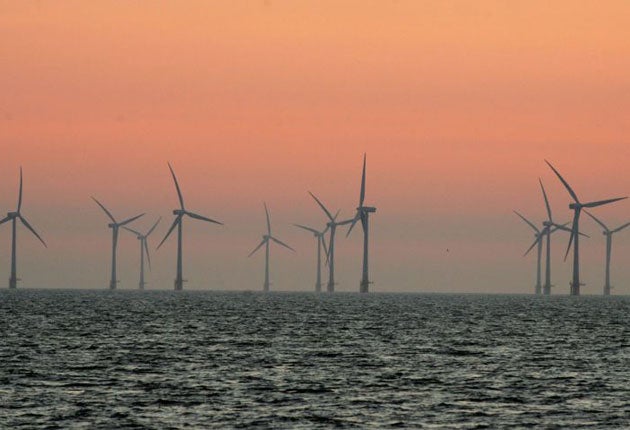Michael McCarthy: The day offshore wind power came of age in the UK

Think of a big power station, a 1,000 megawatt job that can provide the electricity for a major city. Think how enormous it is, visible for miles around with its giant chimneys and cooling towers. Now think of 32 of them. Now think of 32 of them out at sea.
That’s one way of envisaging the real significance of the new programme to build offshore windfarms around the coasts of Britain, announced today by the Government.
Offshore wind has hitherto seemed like a novelty, almost a curiosity, with a few turbines here and a few turbines there, their spinning white blades spottable on the horizon from the odd seaside promenade.
This announcement envisages 6,000 of them, and maybe more, bigger than ever and sprouting from the water in gigantic windfarms in the North Sea, the Channel and the Irish Sea - generating a total of 32 gigawatts of capacity (a gigawatt is 1,000 megawatts).
Overnight it changes offshore wind from a novelty to a serious part of Britain’s energy generation, ultimately up there with coal and gas; you might say today was the day offshore wind power came of age in the UK.
The driving force behind it is Britain’s commitment to meet the EU target of generating 20 per cent of the community’s energy from renewable sources by 2020. Britain’s own share of that is 15 per cent renewable energy; and that in turn means between 30 and 40 per cent renewable electricity; at present we generate about five per cent. The gap to be bridged in ten years is therefore colossal; hence the colossal size of the offshore programme.
It has many other attractive possibilities, recognized yesterday by environmentalists. “It’s the best chance we’ve got of securing energy security, while creating thousands of jobs and giving us a position as a world leader in the green economy,” said Jim Footner, of Greenpeace.
It also means that offshore will now begin to take over from onshore wind, so hated by some people in the countryside. At present there are 2,536 onshore wind turbines turning in Britain (with another 3,177 in the planning system), compared to a mere 228 offshore windmills; but these proportions will soon be reversed.
Even though offshore wind power is more than twice as expensive to install, it does not attract planning protests from people who think their views are being spoiled, and so can grow – in theory – ad infinitum. At least, that is the case for now – until the Offshore Nimby arrives.
Join our commenting forum
Join thought-provoking conversations, follow other Independent readers and see their replies
Comments
Bookmark popover
Removed from bookmarks